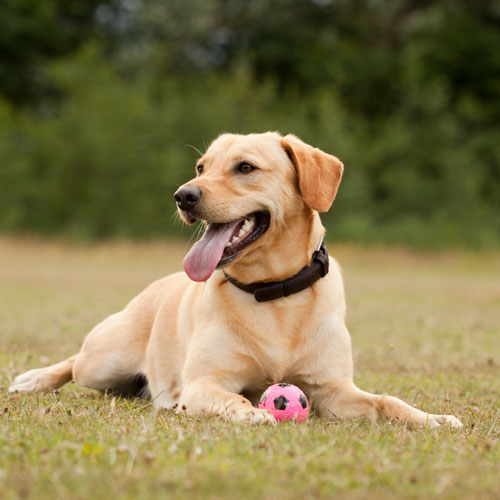
Labrador retriever
"Toby"
Labrador profile
| Exercise: |
| Playfulness: |
| Friendliness with dogs: |
| Friendliness with people: |
| Ease of training: |
| Grooming effort: |
| Affection: |
A little about Labradors - Breed traits
Labradors are a versatile and intelligent breed used in various service jobs, such as assistance jobs and the military. The Labrador is a loving and smart dog suitable for nearly every lifestyle and are a very popular breed. Originally bred for retrieving, hunting, and agility they require an active lifestyle, but are friendly and love to just hang out with family also.
LABRADOR HEALTH INFORMATION
Labradors are a generally healthy breed, however they can inherit some hereditary problems, such as hip dysplasia, cancer, progressive retinol atrophy and heart problems. Labradors love their food, so obesity is also a common problem for their breed as they will eat anything put in front of them. Problems such as diabetes, entropion, distichiasis and tricuspid valve dysplasia is also occasionally seen in Labradors as well.
Physical Statistics
Lifespan: 10-12 Years
Avg height: 53-61cm
Avg weight: 24-36 kg
Insurance for Labradors
View our page on insurance for Labradors to see the common health issues vets describe for Labradors and what you should be covered for, and the health issues for Labradors that are covered by pet insurance.
Grooming
Labradors are known for their double-coated fur, featuring a short and straight topcoat that's both waterproof and easy to maintain. They come in various coat colours, including yellow, brown, black, and even dark fox red. While Labradors do shed, their grooming needs are generally straightforward. Their topcoat, which is short and dense, provides excellent protection from the elements, particularly in cold weather and water. Underneath, they have a softer undercoat that aids in insulation and comfort. This coat adaptation not only makes Labradors resilient to different climates but also highlights their suitability as outdoor companions.
Training and exercise
Labradors have an affectionate nature and love spending quality time with their families and owners. They are playful and thrive on interaction, making them excellent companions for an active household. Due to their high energy levels, regular exercise is a must to keep them happy and healthy. When left alone for extended periods, Labradors can sometimes get mischievous, so it's essential to provide them with engaging activities. Chew toys are a fantastic way to keep them occupied and prevent destructive behaviours like digging holes or chewing on furniture. Consistent training and positive reinforcement can also help channel their enthusiasm.
A day in the life of "Toby"
Retrieve. Must retrieve. He runs through the yard, nose sniffing as his head wags along the ground trying to find anything for his human.
He’d heard the car door slam and knew his people were now home. Now to find the perfect gift.
He spots the sock of his little human, left beside the stairs. That will do.
Gently, careful not to ruin the gift, he grabs the sock in his mouth. Ears pricking, he can hear the gate. They’ve now entered the yard!
Must run, before they get inside.
He turns the corner of the house and sees his people walking towards the front door.
His tail starts wagging and he begins to whine, ‘accept my gift!’
Dropping his gift, he wiggles while receiving ear rubs. This is the life.
He follows his people into the house, straight to the kitchen. His little human sits on the floor next to him, and speaks about something called tractors, while his other people begin cooking.
His mouth begins to drool, and he watches every motion in the room. Chop, chop, stir. It all smells too good.
Something falls. He leaps, tongue out as he does and reaches the food. Gone.
‘Daaaaad, Toby ate something’.
‘Not again.’
His tail wags again as his human approaches, drumming against the wooden cupboard.
At least this time it wasn’t a sock.
Hear from our customers
“I’ve never had such a good experience with an insurance company. Such a good experience during such a difficult time”. – Sandra, owner of Ide in NSW.
